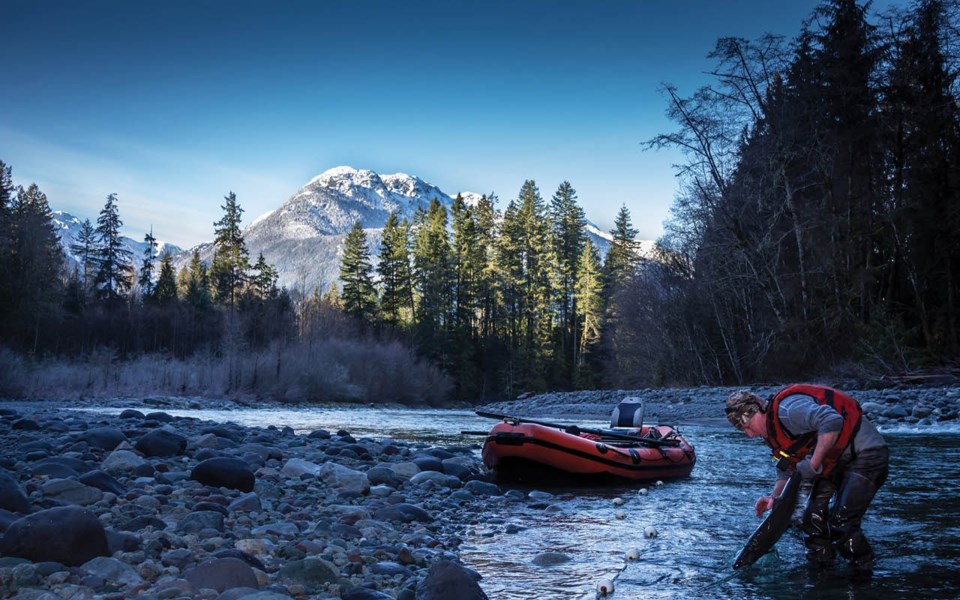For the past several years, Fisheries and Oceans Canada (DFO) has been carrying out a conservation initiative aimed at getting dwindling salmon returns to their prior historical levels.
Focused primarily on chum and chinook locally, the broodstock program is an effort to better understand the often unpredictable nature of the species' return to the Squamish River system.
"The trends are all over the place," said Jordan Uittenbogaard, operations manager at the Tenderfoot Creek Hatchery, of the last decade of chum returns. "I think it was back in 2016 when we had a record return of chum to the hatchery, and then the following year it was an all-time low."
Scientists recorded approximately 2,000 returning chum to the hatchery last year, below its rough annual average of 6,000, and well below the record of 26,000 set in 2016, the highest number tallied since the hatchery began counting in 1981.
Hatchery staff will collect chum spawn from the Tenderfoot Creek before fertilizing and hatching the eggs in its facility and redistributing the fry to streams, creeks and rivers around the Squamish area. It's a process that "mimics Mother Nature" while fostering higher survival rates than usual "because they're in that setting with no predators and they are getting fed," Uitenbogaard said.
"We will put a certain amount of eggs back into Tenderfoot Creek to ensure that we get brood stock returning, so adults continue to come back. Then, the surplus eggs, we divvy up unto local urban streams in Squamish. We'll do three to four streams per cycle—a cycle is four years—and what we're trying to do is transplant these chum into these streams for four years to build back populations to historic levels," he added.
After a four-year cycle, the scientists move to a new set of streams, a process they will repeat and, if effective, continue until "we should technically have a really healthy population of chum," Uitenbogaard said.
A fatty, nutrient-rich fish, chum play a vital role in the local ecosystem, explained Dave Brown, local member of the Sea to Sky Fisheries Roundtable.
"When they lay their eggs, not only do they create more chum salmon, they put nutrient load back into the river, which feeds all salmon, trout and steelhead species," he said. "The Squamish itself is a very nutrient-poor river, so these salmon, they're like a fertilizer for the entire river and they help other species do well. Poor chum returns can be the canary in the coalmine for poor returns of other salmon."
The enhancement program is smaller in scope for pink, coho and chinook salmon, which have seen stronger returns than chum in recent years, relative to their respective populations. Last year was the first since the program was launched in 2014 to see chinook return to their home rivers to spawn, and although it's still early, Uitenbogaard said "just visually, we had a large hatchery fish return" of chinook. "It looks like our survival (rate) is going to be great."
Scientists insert microchips into the fish fry they capture to track their migration route. (The DFO asks anglers to turn in the heads of salmon with their adipose fin missing—a sign that the fish has been chipped.)
"It tells us a lot," Uitenbogaard said. "That pin goes with that fish over its entire life and when it's caught by a sport angler, commercial fisheries or it returns to us, we can now take that head from that salmon, that pin, and it gives us the whole assessment for the program."
The DFO has also partnered with the province, the Squamish Nation and the Squamish River Watershed Society to open up fish habitat in the region. For years, a large boulder in the Upper Elaho River has choked off "kilometres of abundant habitat" for salmon, said Uitenbogaard. Blasting has already cleared the boulder, and hatchery staff will release 15,000 chinook fry into the upper reaches of the river in May.
"This will hopefully result in a healthy and new population of chinook salmon in the coming future," Uitenbogaard added.




